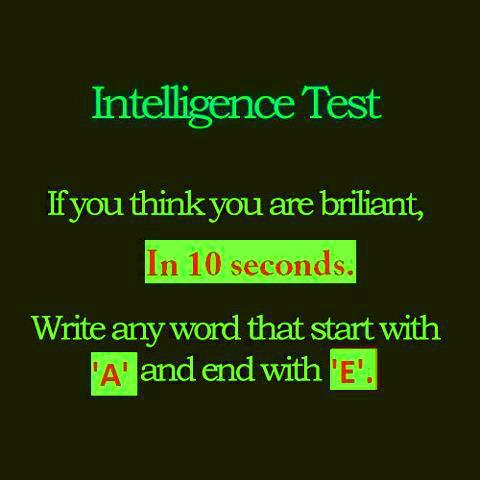Intelligence test: If you think you are briliant, In 10 seconds. Write any word that start with ‘A’ and end with ‘E’.
When I first came across this so-called intelligence test, I first noticed all the errors in the test itself. So my first thought was to correct the errors and then share the corrected version of this test.

But then I realized that the above graphic could serve as a test of grammar and spelling (and not intelligence), so I posted the above graphic to Facebook with the following statement:
Now the tough part for some of you will be finding the 6 grammar and spelling errors in this intelligence test. There could actually be 9 grammar and spelling mistakes, depending on how strict you want to be.
Surprisingly, of the 657 responses to this intelligence test, at least 95% focused on answering the challenge in the image with such words as ape, are, age, adobe, alive, Alice, ace, apple, and other relatively short answers. Some answered with clear challenges to the test itself with words like asinine, arse, and asshole.
And some came up with incredible words like: antihistamine, acquaintance, appropriate, agriculture, alphabetize, alternative, amphetamine, attendance, applesauce, apprentice, assimilate, allegiance, astute, anemone, assuage, andante, attitude, aptitude, altitude, audience, adequate, antelope, advocate, allocate, attenuate, aggravate, and ambulance. And a city near where I live: Albuquerque.
And one person answered the test literally: any word that start with ‘A’ and end with ‘E’.
Only a few Facebook followers actually read my introductory statement and noted the errors in the above intelligence test. Without further ado, here are 13 possible spelling and grammatical errors:
1. Briliant should be spelled brilliant.
2. In should not be capitalized.
3. Write should not be capitalized.
4. Start should be starts.
5. End should be ends.
6. There should be no period (full stop) at the end of in 10 seconds. There should be a comma.
7. The quotes around A should be double quotes. Personally, I think it can go either way: single quotes or double quotes. At least one style website says that single quotes are the correct use for highlighting something like ‘x’ marks the spot.
8. The quotes around E should be double quotes. British usage suggests using single quotation marks here with the period outside the quotation marks.
9. 10 should be spelled out as ten. Some writers believe this is more a choice than a law of style. In British style, 10 is perfectly acceptable.
10. The period at the end should be within the quotation marks. But, note, at least one style manual says it’s now acceptable to put the period outside of the quotation marks. So #10 might be a stretch. See also note #8 above.
11. Should the sentence read starts with an ‘A’? Several people thought the an should be there in the sentence twice. I don’t think the an needs to be there in either instance.
12. Should the sentence read ends with an ‘E’?
13. Should there be a that here: If you think that you are brilliant. I think this is a stylistic choice. It seems to me in modern English, the word that is often optional in such a sentence structure.
So the final instructions could read as follows: Intelligence test: If you think you are brilliant, in ten seconds, write any word that starts with ‘A’ and ends with ‘E’.
Oh, and for your next challenge: Can any of you name an a-to-e word longer than the 13 characters of antihistamine?
About John Kremer
John Kremer is author of 1001 Ways to Market Your Books, the Relationships Matter Marketing program, and many other books and reports on book marketing, Internet marketing, social media, and book publicity. -- John Kremer on Book Marketing.